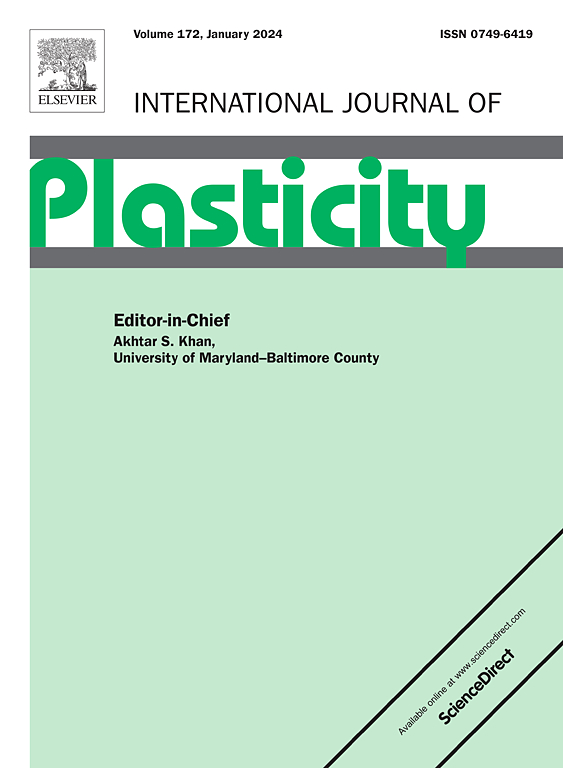晶内非晶纳米颗粒金属纳米复合材料的原子尺度变形机制
IF 12.8
1区 材料科学
Q1 ENGINEERING, MECHANICAL
引用次数: 0
摘要
分散强化是一种完善的方法,用于提高金属材料的机械性能,通常利用晶体分散,如金属间或陶瓷颗粒。最近的研究表明,通过增材制造技术制备的非晶B4C纳米颗粒增强的铜基纳米复合材料具有显著提高的强度和延展性。在这项研究中,我们采用分子动力学(MD)模拟来研究这些纳米复合材料力学性能增强的原子水平机制。与晶体分散体相比,颗粒内分散的无定形B4C纳米颗粒由于其固有的自由体积和结构无序性,表现出优越的位错吸收和发射能力。因此,周围的铜基体应力集中程度降低,能够更好地吸收和分配应变能,从而延缓破坏。值得注意的是,非晶纳米颗粒在变形过程中通过键开关和剪切转变在相对松散的局部区域发生致密化,这有助于提高应变硬化率。通过原位透射电镜实验验证了MD模拟预测的位错动力学,并且应变硬化行为与先前的实验结果一致。这项工作为利用非晶分散体改善金属材料的机械性能提供了物理基础。本文章由计算机程序翻译,如有差异,请以英文原文为准。
Atomic-scale deformation mechanisms in metal nanocomposites with intragranular amorphous nanoparticles
Dispersion strengthening, a well-established approach for enhancing the mechanical properties of metallic materials, typically utilizes crystalline dispersions, such as intermetallic or ceramic particles. Recent studies have shown that copper-based nanocomposites reinforced with intragranular amorphous B4C nanoparticles, fabricated via additive manufacturing, exhibit significantly improved strength and ductility. In this study, we employ molecular dynamics (MD) simulations to investigate the atomic-level mechanisms responsible for the enhanced mechanical performance of these nanocomposites. Compared to crystalline dispersions, the intragranularly dispersed amorphous B4C nanoparticles exhibit superior dislocation absorption and emission capabilities, owing to their inherent free volume and structural disorder. As a result, the surrounding copper matrix experiences reduced stress concentration and is better able to absorb and distribute strain energy, thereby delaying failure. Notably, the amorphous nanoparticles undergo densification during deformation via bond-switching and shear transformations in relatively loosely packed local regions, which contributes to the higher strain hardening rate. The dislocation dynamics predicted by MD simulations are validated through in-situ transmission electron microscopy experiments, and the strain-hardening behavior is consistent with prior experimental findings. This work provides a physical foundation for improving the mechanical properties of metallic materials through the use of amorphous dispersions.
求助全文
通过发布文献求助,成功后即可免费获取论文全文。
去求助
来源期刊

International Journal of Plasticity
工程技术-材料科学:综合
CiteScore
15.30
自引率
26.50%
发文量
256
审稿时长
46 days
期刊介绍:
International Journal of Plasticity aims to present original research encompassing all facets of plastic deformation, damage, and fracture behavior in both isotropic and anisotropic solids. This includes exploring the thermodynamics of plasticity and fracture, continuum theory, and macroscopic as well as microscopic phenomena.
Topics of interest span the plastic behavior of single crystals and polycrystalline metals, ceramics, rocks, soils, composites, nanocrystalline and microelectronics materials, shape memory alloys, ferroelectric ceramics, thin films, and polymers. Additionally, the journal covers plasticity aspects of failure and fracture mechanics. Contributions involving significant experimental, numerical, or theoretical advancements that enhance the understanding of the plastic behavior of solids are particularly valued. Papers addressing the modeling of finite nonlinear elastic deformation, bearing similarities to the modeling of plastic deformation, are also welcomed.
 求助内容:
求助内容: 应助结果提醒方式:
应助结果提醒方式:


